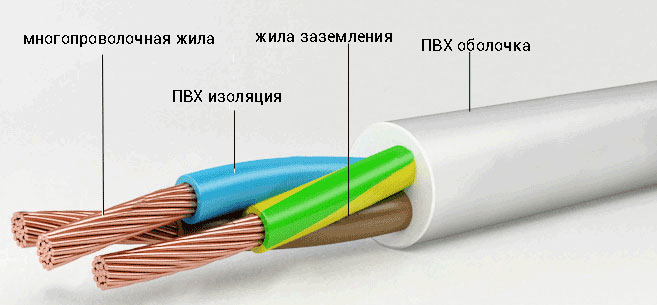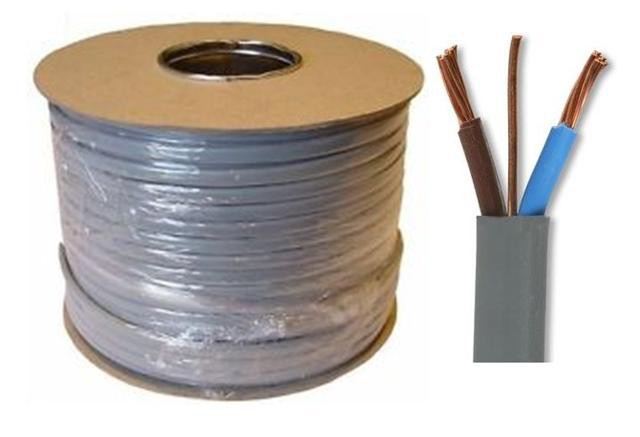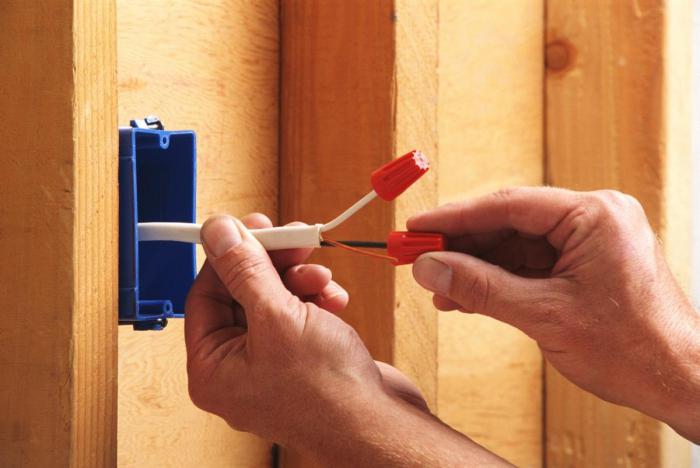If you are going to buy a VVG cable at an adequate price wholesale or retail, you have come to the right place. We will try to satisfy your requests in terms of quantity, quality and reasonable cost.
Purpose and application
VVG belongs to the group of power wires and is a prefabricated structure of one or more electrical wires with a cross section of different diameters in a dense protective sheath. Such a wire is widely used in everyday life for connecting various electrical appliances due to its balance between price and workmanship. This is a great competitor even for its foreign counterparts, which ensures it is in high demand in the market.
You can buy VVG at a nice price in Moscow in our online store. We deliver products to any city in Russia, so it is convenient to buy a VVG cable without leaving your home.
Compared to other types of wires, VVG is one of the safest and most efficient in terms of power consumption. This was achieved by an improved protection design.
All wires of the VVG group have high level fire resistance, weigh little and have a known strength, flexibility and ductility.
So, for a reasonable price you can buy products of the widest range of applications:
- Installation in the open air, on the street (on walls or suspended method);
- In rooms, including those with high humidity;
- AT wooden houses(should be laid in the corrugation);
- In mines and collectors;
- In buildings with increased fire risk;
- In concrete screeds.
The only limitation is that the VVG cable cannot be laid in the ground if it is not an armored modification, otherwise mechanical impact (moisture in the soil, rodents, plant roots) will quickly render it unusable.
Design
The most important thing in the design of the electrical wire, what you need to focus on when buying VVG in addition to the price, is the number of conductive wires. They can be from two to five. Differs in types and materials and includes such main ingredients, how:
- Insulation. Manufactured from polyvinyl chloride plastic (PVC). A standard color designation has been adopted for ease of use and safety: zero conductors are marked in blue or light blue, the ground wire is “dressed” in yellow-green insulation. The remaining wire (white, red, brown) is the phase.
- Conductor. Copper or aluminum is the most commonly used, although a small number of wires use solid strands. Copper can be single- and multi-wire, twisted into one wire. The number of cores depends on the applied voltage;
- Protective outer shell. For example, for laying at nuclear industry enterprises, the cores are additionally protected by an ionizing layer resistant to radiation. There are armored options for laying in places where there is a risk of damage to the insulation: in the ground, sewers, etc.
Depending on the application and purpose, this composition may differ from type to type. In order not to make a mistake with the choice and buy a suitable VVG cable, it is important to understand:
- Cable thickness determined by power and voltage;
- Transverse section wire and conductive core depends on the resistivity ρ and the maximum current;
- The form(flat or round) andcomposition of the outer containmentare selected depending on the conditions in which the laying is supposed to be: seasonal fluctuations in temperature, open or closed installation (i.e. underground or outdoors), the amount of sunlight, air humidity.

From the video you will learn how to choose the right section cable VVG:
Decryption
A symbol is applied to each VVG. The correct interpretation of the abbreviation and its understanding will give you a huge advantage in choosing and buying a wire in Moscow. Our price is one of the lowest in the VVG group.
If VVG conductors are made of copper, this is not indicated in any way. For aluminum conductors, the letter A is placed before all letters of the abbreviation.
Conductor insulation material (first letter) |
|
polymer materials |
|
polyvinyl chloride (PVC) |
|
polyethylene based material |
|
Cable sheath (second letter) |
|
polyvinyl chloride (PVC) |
|
sheath in the form of a hose |
|
polymer outer insulation |
|
polyethylene hose |
|
Degree of protection (third letter) |
|
armored |
|
flexible, additional protection No |
|
Fire safety marking |
|
ng | the cable does not support open combustion, reduced flammability |
ng-ls | low smoke emission during the melting of insulating materials |
ng-hf | no corrosive gases are emitted during the melting of the wiring |
ng-frls | when melted (not when open burning!) the cable emits a minimum amount of smoke and gas |
ng-frhf | this type of cable has all the protective properties of the listed types at once |
Specifications
Before you buy the desired VVG, check out the current characteristics, because. The price strongly depends on the options chosen.
- Electric current frequency: 50 Hz;
- Permissible rated voltage - 660 and 1000V;
- Maximum operating temperature +70 °C;
- Operating conditions: from -50 to +50 °C, relative humidity - up to 98%;
- The minimum bending radius of a wire without protective covers is at least 7.5 of the power cable diameter.
The service life of the cable is 30 years. Warranty 5 years, but with improper storage only 2 years. Proper storage: the wire is wound on a wooden bobbin and kept indoors.

Specifications and color coding of VVG (on the example of differences between VVG and AVVG cables):
Hello dear reader! If you again looked at my website page, then you are interested in the following question: what is a VVG cable?
This question is often asked by young, inexperienced electricians or just people who are faced with the problem of which cable to choose for different purposes. Let's try, as usual, in a simple way to tell everything that I know about the VVG cable.
Cable abbreviation
Most importantly, this cable has electrically conductive conductors - copper. In one of my articles, now I remember ... .., well, this one () contains an informative description of the abbreviation of the main brands of cables. So, our VVG cable does not have the letter A in front, which means it is not aluminum.
The cores of the cable are round, soft (that is, multi-wire).
A big plus for this brand of cable is the different execution of the number and cross sections of the conductive cores. The number ranges from 1 to 6. The cross section is from 1.5 to 240 mm squared.
The letter B stands for insulation material. For this cable, the insulation is made of PVC. The second letter B is also polyvinyl chloride. Conclusion: means double insulation. The letter G means flexible.
So, one of the answers to the question: what is a VVG cable, we figured it out by deciphering the VVG.
Where can I use the VVG cable
What is good about the VVG cable is that it can be used for various purposes. Connect electrical installations, lighting, electrical installation of internal wiring. Personally, I am a big fan of working with the VVG cable, but I try to use it at temperatures not lower than -15 degrees. Cable insulation may crack when bent. Also, if I need to lay it underground, I use pipes or metal boxes, cable channels, etc. In short, I do everything so that the cable is not damaged mechanically.
Why is the insulation of different colors in the VVG cable?
Dear reader, as they say: "everything is for you, for your convenience!" When wiring, in order not to get confused, you will already know which phase is brown, which zero is blue, which ground is yellow-green.
Well, what else can be said about the VVG cable, try to make a bend when laying with a radius of 7.5 outer diameters.
I tried to answer your question: What is a VVG cable? Everything you need to know about the cable is described above. Select the cross section according to the power of electrical appliances. You can see the nomenclature and parameters of the VVG cable on this site.
Write comments, additions to the article, maybe I missed something. Take a look at, I will be glad if you find something else useful on my site.
VVG consists of conductors made of copper and covered with a layer of PVC. It has a flat shape and in most cases is used to transmit electrical energy with its further distribution in various stationary installations. This cord is nominally rated for voltages up to one kilowatt. Some brands work at higher rates. Such a cable can be laid both in dry rooms and in those that are characterized by high humidity. Often, VVG wires can be found in special cable blocks, overpasses, and even in open space. It should be noted that their laying is allowed in horizontal, inclined and vertical routes, as well as in places that are characterized by an increased level of vibration. The only place where it is not desirable to lay such a cable is underground. The main and most common VVG wires are described below.
Cable structure VVG-P ng
Each core here is single-wire and has a round shape. Its nominal cross section can be up to 16 millimeters square. For the manufacture of insulation used polyvinyl chloride plastic. It should be noted that the shell of individual cores has a different color. The outer ball is characterized by reduced flammability and in most cases has a white color. Laying is recommended to be carried out at a temperature in the range from 15 to 35 degrees of heat and humidity up to 98%. This power cable, like his other brands, has a flat design. The characteristics of the VVG-P ng wire allow it to be used at fairly high voltages.

Cable VVG-P ng LS
This variety is characterized by a reduced fire hazard, and the LS (Low Smoke) coding indicates that the product has a low level of gas and smoke emission. Since it does not spread combustion, it is most often used for the distribution of electrical energy in cable rooms, structures and installations, where the variable is from 660 V to 1000 V at a frequency of 50 Hz.
The structure of the veins
The wire VVG-P ng LS has a conductor that conducts electricity, made of copper and can be single-wire or multi-wire. If there are two or three cores in the twist, then they all have the same cross section, and if there are four, then the last one has a smaller one. It serves for grounding and is called zero. In the production of insulation, a special polyvinyl chloride composition is used, which is characterized by high resistance to combustion. The shell of each core has a different color, while the zero is always blue. The thickness of the inner layer is at least three millimeters. It should be noted that the gaps between the cores and the insulation of the PVC composition are filled with it.

Specifications
Installation and laying of this VVG wire is allowed to be carried out without preheating at a temperature of at least minus fifteen degrees. Allowed for use temperature regime in the range from -50 to +50 degrees. As for non-ignition, for this cable, the maximum temperature of the conductive cores is set at four hundred degrees.





